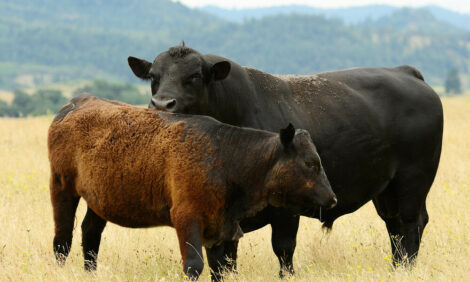



Tips On Controlling Parasites In The Feedlot
US - Feedlot receiving protocols for new arrivals usually consists of a round of vaccinations, and sometimes metaphylactic treatment with an antibiotic. If it doesn't, a receiving protocol should also include a deworming plan as well.
Often, as part of a backgrounding or preconditioning protocol, feeder calves must be dewormed as well as vaccinated; however, if the feeder is going to vaccinate all recently aquired calves, it is well worth the time and money to deworm those calves as they enter the feedyard.
In comparison to pastured cattle, cattle housed in dry lots are at a relatively low risk for infestation by internal parasites. Because they are consuming feeds with virtually zero fecal contamination from other animals, the chances of picking up infective spores or eggs orally, is fairly minimal.
Also, because they are not grazing pastures, nor are they drinking from stagnant pools of surface water, the exposure of the calves to the intermediate hosts of many parasites are also absent from the scenario. However, given these nice interruptions to the parasitic life cycle, parasites can still cause some significant economic losses in feedlot cattle.
One of the peculiarities of parasite management in the feedlot is the continuous cycling of cattle through the feedyard. Because a feedlot is not an enclosed, all-in-all-out system, there exists potential of exposure of dewormed animals to those that may not have been adequately treated.
Some of this exposure may occur in hospital pens, where often cattle from many different pens at different stages of feeding, will come together for treatment, for a time, and often get returned to their home pen after they show signs of convalescence from their ailments. These returning animals may potentially carry parasites back to the home pen, thus infecting the entire group.
The ascarids, or roundworms, are an interesting subject to contemplate. Ascarids can exist in the gut lining of the host animal as fourth stage larva. These larvae will molt and become adults only after the existing adults in the host gut are removed. Therefore, it is possible for a calf to have a more severe ascarid burden after the initial deworming.
Because of this pesky feature of the ascarid lifecycle, it is prudent to deworm cattle with a product that has activity against immature stages of the parasite, as well as persistence in the animal, so that when the parasite eventually reaches an age and maturity at which it is susceptible to the dewormer, it will be efficiently removed from the calves system.
Timing of deworming is not as critical in feedlot cattle as it would be for pastured cattle. It is much more important to get the product into or onto the calves as quickly as possible, so that there is minimal negative impact on gains while the calves are on feed.
In feedlots, there is often little escape from external parasites, such as flies and lice. These can be effectively combated with a variety of products and techniques.
Pour-on dewormers will have some efficacy against flies, ticks, and lice, but in most cases, persistence is not as long as we'd like it to be.
In many cases, parasite control products have withdrawal times that must be managed, which often necessitates the utilisation of premises sprays and other preventative measures to keep flies from congregating in areas where they would prefer to reproduce.
Some of these measures may include keeping damp areas dry, or increasing air flow through buildings to limit the flies from landing on walls, floors, or fences in the lots with the cattle.
In some cases, flies are the transmitters of disease, such as anaplasmosis. Furthermore, flies do not respect the boundaries of fences and fencelines, so keeping fly numbers under control in a feedlot is critical to maintaining the health of all of the cattle in the entire feedyard.
Lice can be a particularly frustrating problem. They never seem to miss a winter. The nits of lice are so well protected that a second treatment, two weeks after the first, is necessary to truly impact the louse population.
However, again, this pest can be dealt with in an effective manner, with a product that has a reasonable level of persistence. Avermectins generally will have sufficient persistence, as will some of the synergised permethrins that are formulated specifically for louse control.
Coccidia can be a costly problem in the feedlot. Typically winter coccidiosis will manifest itself as lumps of bright red, coagulated blood in the diarrheic feces of the calves. Cattle will typically appear normal, but performance will be hindered by the parasite.
In some cases, cattle will develop “nervous coccidiosis,” in which a toxin that is produced by the coccidian can cause malfunctions of the central nervous system. About half of the calves affected with nervous coccidiosis will die, thus this is a situation the feedlot producer would like to avoid.
Coccidia can easily be controlled with the inclusion of a coccidiostat in the feed ration.
As with all veterinary products, it is important to monitor and manage all withdrawal times for all products used. As with any herd health protocol, consultation with a bovine veterinarian will be the most integral component of creating a cost effective, efficient parasite control protocol for feedlot cattle.


